The present season has certainly become nothing short of a rollercoaster ride for fans of Lyon, with their attention focused on the wrong end of the table.
For a club with such a rich and successful history, the managerial carousel this season has perfectly depicted the fall of a side once challenging alongside similar French powerhouses for a shot at the Ligue 1 title.
Previous head coaches Laurent Blanc and Fabio Grosso were undeniably great on the pitch, having both lifted the World Cup during their playing careers- but this failed to translate to operating a high-functioning football team from the sidelines.
So up steps inexperienced Frenchman Pierre Sage, a figure synonymous with the development of youth talent, but supposedly lacking the managerial CV to effectively navigate one of the toughest tasks in European football.
Having taken charge with Lyon at rock bottom of the table and only winning 1 of their previous 12 matches, Sage has reinvigorated his team, positively affecting team psychology and steering them in the right direction.
With Lyon creeping back into the top half of Ligue 1 and a semi-final encounter in the Coupe De France, the future appears much more optimistic with a man who has been credited by his players for increased defensive stability and harmony within the dressing room.
This Olympique Lyon tactical analysis will begin to highlight how Pierre Sage tactics have worked to rectify lingering issues that threatened to topple the French goliaths before his appointment.
With a focus on an increased tempo and a modern aggressive style, the present analysis will address how his tactics and philosophy are deeply engrained within his footballing values, placing emphasis on positional play and creativity.
Pierre Sage Tactics & winter rebuild
Whilst the majority of the credit can be placed upon the shoulders of Pierre Sage for the way he has transformed this Lyon side in such a short amount of time, it would be remiss to ignore the increased investment we observed in the January window.
In an attempt to negate glaring issues and areas of weakness, Lyon invested over €50 million in the acquisition of new stars- making Les Gones the largest spenders across the entirety of Europe during the winter transfer period.
These signings included loan deals for Premier League players Saïd Benrahma and Orel Mangala, a double swoop for KAA Gent’s Malick Fofana and Gift Orban, along with the acquisition of experienced defensive midfielder Nemanja Matić.
Whilst desperate times have called for desperate measures to be taken by owner John Textor, these necessary signings have integrated well into the existing squad, allowing Pierre Sage to instil his principles and highlight his squad’s strengths with increased competition and depth.
Despite only being in and around the club for a matter of weeks, a number of the winter transfers have become integral to Sage’s philosophy, positively impacting Lyon’s results.
Pierre Sage style in possession
When taking charge at Lyon after the dismissal of Fabio Grosso, Pierre Sage identified the most crucial immediate change would be to start winning matches in whatever way possible.
As results have begun to swing in their favour regularly, Pierre Sage has had the opportunity to introduce different tactical adaptations that aim to develop footballing principles and values over the long term.
Tactical shifts can be simple, especially when looking to gel with a new set of players, with all eyes focused on the collective goal of staying in the division.
Sage has been credited by his players for ‘bringing Lyon fresh air’ whilst simplifying team tactics to be more efficient on both sides of the ball.
Throughout 2024, we have seen Lyon set up in the 4-3-3, a formation integral to the way that Sage wants to play and how he feels he can maximise the output of his star players.
Their desired formation usually consists of a 3-man midfield anchored by winter signing Nemanja Matić, with the likes of Maxence Caqueret and Corentin Tolisso given the freedom to roam further forward as the advanced No.8s.
It had become consensus that the creative talents of Caqueret were being wasted in a deeper role under previous management, forcing Sage’s hand to deploy him higher up the field.
The wise, assured figure of Matić has been excellent since his inception at Lyon, providing a useful balance between defensive actions and progressive distribution.
His 100% passing accuracy from 83 passes in their recent encounter against Lorient epitomises his ability to control the midfield and often instigate the first phase of build-up play.
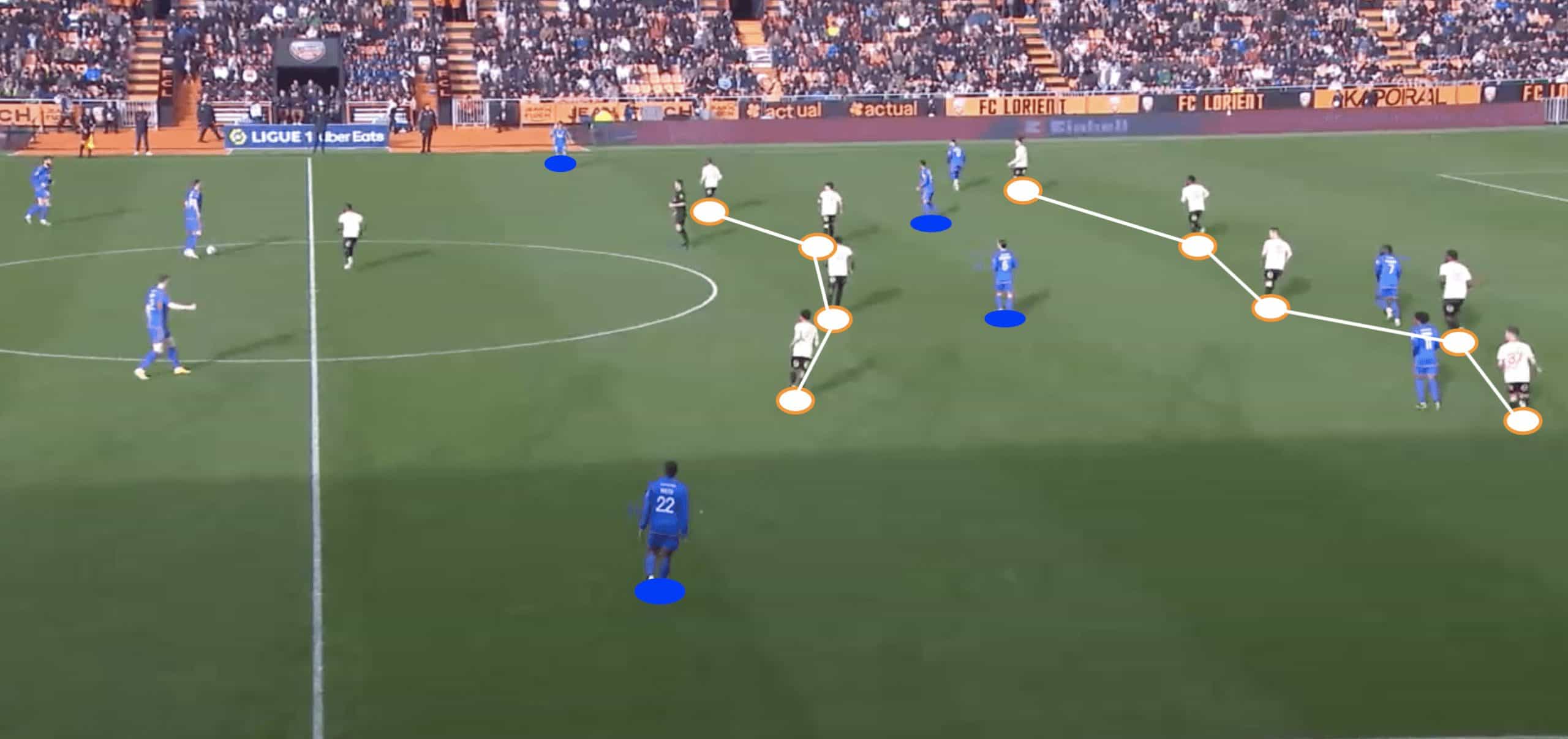
With Matić as the midfield general, Caqueret has been able to impact the game in more advanced areas, operating between the lines and having the opportunity to make darting runs in and around the penalty area to stretch the defensive line.
This has also provided further opportunity to coordinate with the Lyon offensive trio, as Rayan Cherki can often be seen dropping deeper to collect the ball in pockets of space.
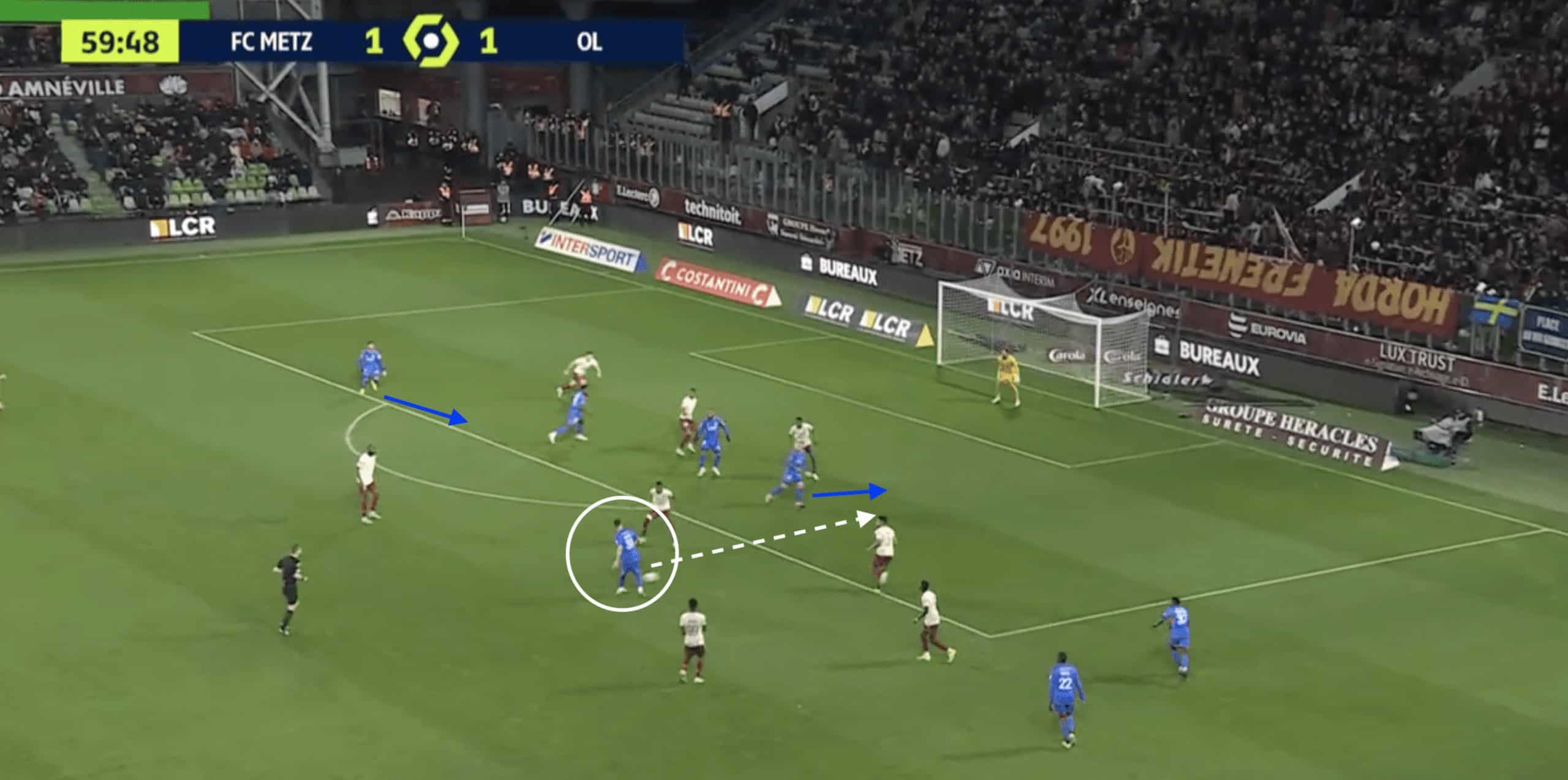
The height of the Lyon fullbacks has also resembled an important switch towards a more aggressive attacking team as a whole.
In the initial phase of build-up, we can see the likes of Tagliafico and Maitland-Niles/ Mata operating in advanced positions on the flanks, creating important passing outlets to progress the ball.
With the added defensive stability that Matić brings to this Lyon side, we can often see their 4-4-2 switching into more of a 3-4-3/3-4-1-2 with Matić dropping into central defence.
Their ability to stretch the defensive line, in turn, creates more pockets for the forward three to operate and interchange.
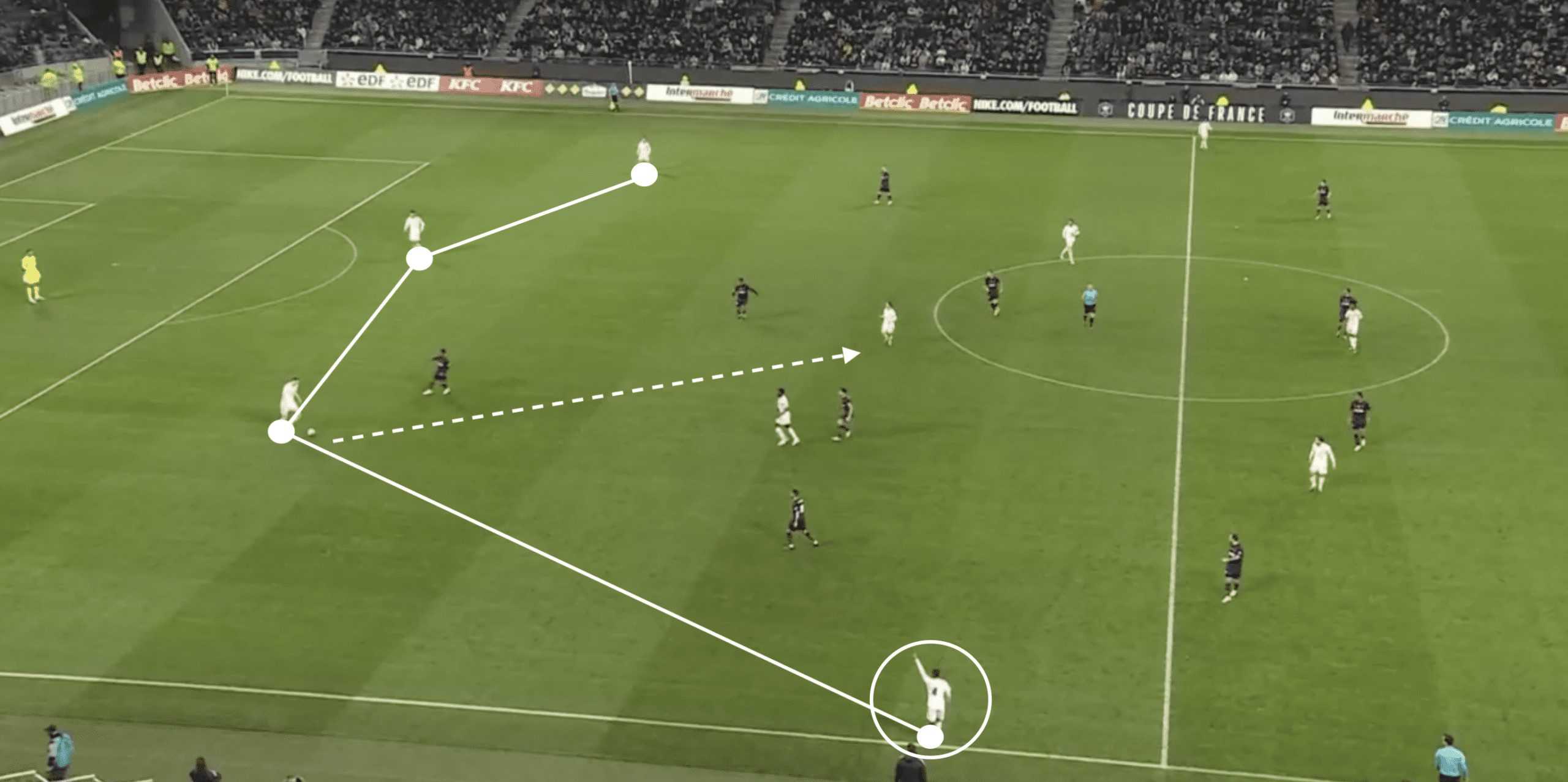
It has become a crucial point of call for Lyon, which was evident in their recent match against Lorient when the opposition were proving resolute defensively.
With the home side defending valiantly for the majority of the affair, the deadlock was eventually broken after a Clinton Mata cross was headed goalward by his onrushing defensive counterpart, Nicolás Tagliafico.
His movement in and around the area was crucial in overcoming Lorient’s stout defensive block and, in turn, allowed the Lyon attack to play with less pressure and more freedom to find a second goal later in the match.
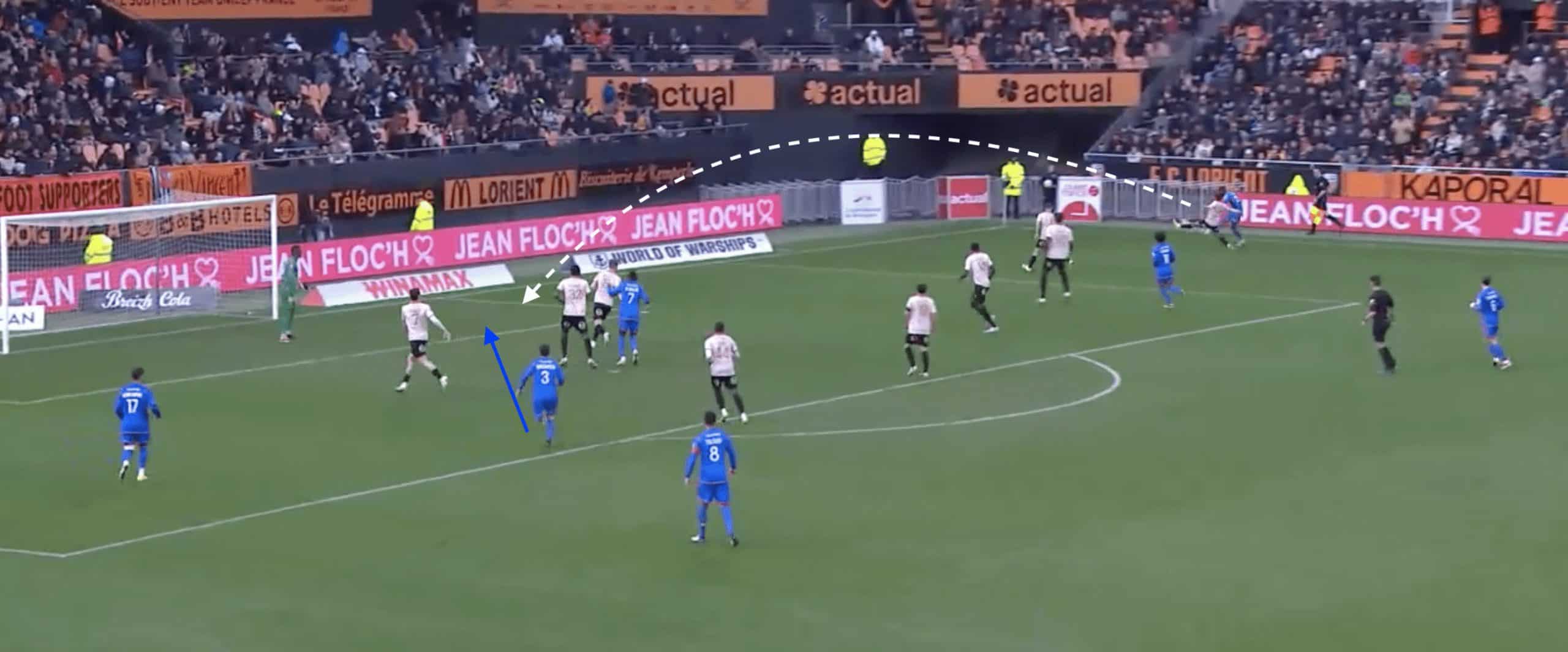
Rockstars in transition
A vital feature of the new-look Lyon would be that Sage has instructed his players to play as quickly and as direct as possible, especially when regaining the ball in transition.
Whilst being likened to an inexperienced version of Pep Guardiola for his work in possession, Pierre Sage has been shown to resemble Jürgen Klopp when it comes to pressing intensity and speed of counterattacks.
Sage himself used the analogy that his team must ‘stop playing the cello and start playing the electric guitar’ when referring to Lyon’s ideal identity and the ability to cause fear and confusion in the opposition with their direct nature.
Their intentions from the outset have been clear, and they are conscious that their pressing efforts must be consistent throughout the match.
In the opening moments of their match at home to OM, Matic intercepted the ball in the middle of the park before finding the ball through to Nuamah, who could launch the explosive counterattack with Lyon numbers committed forward into the opposition’s half.
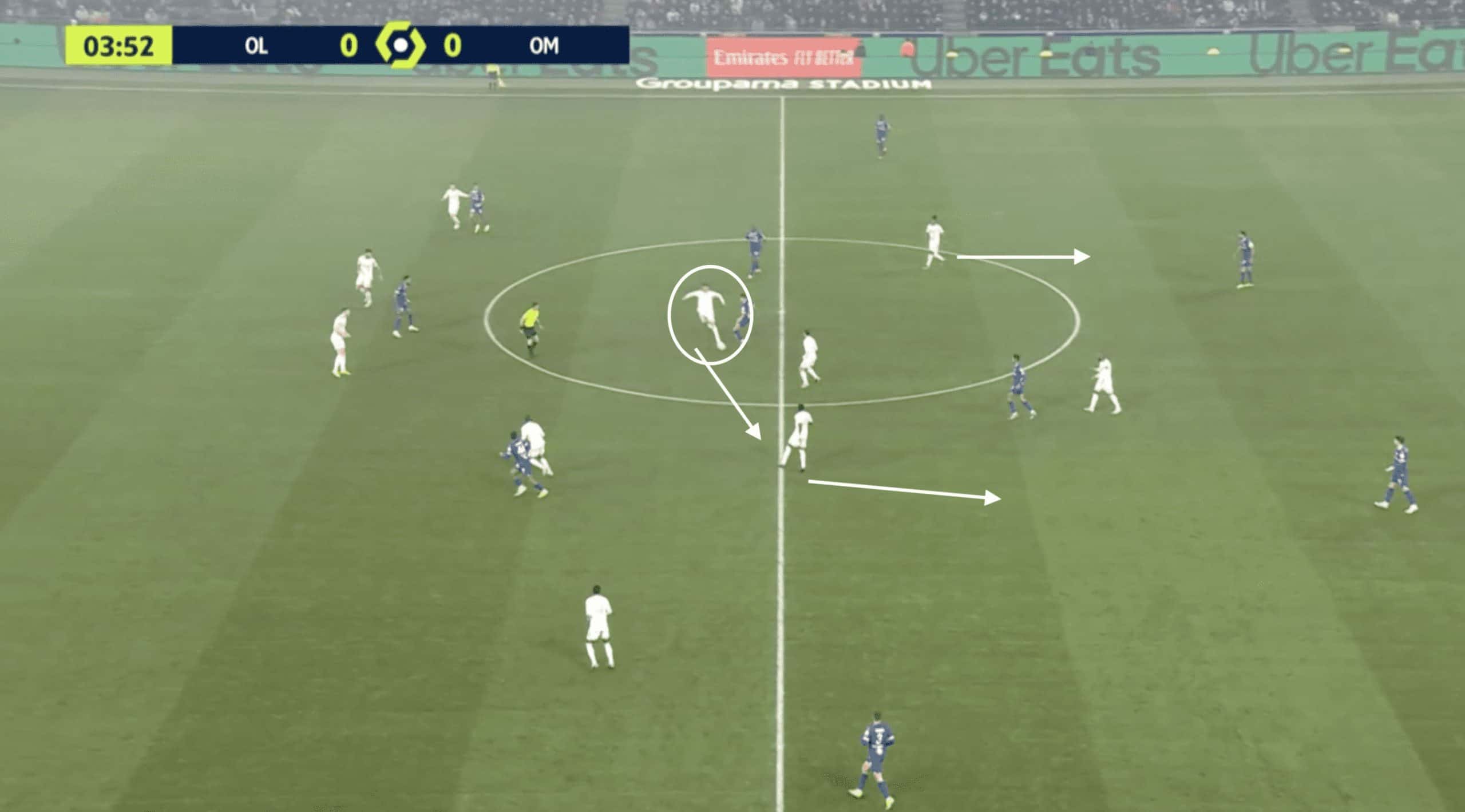
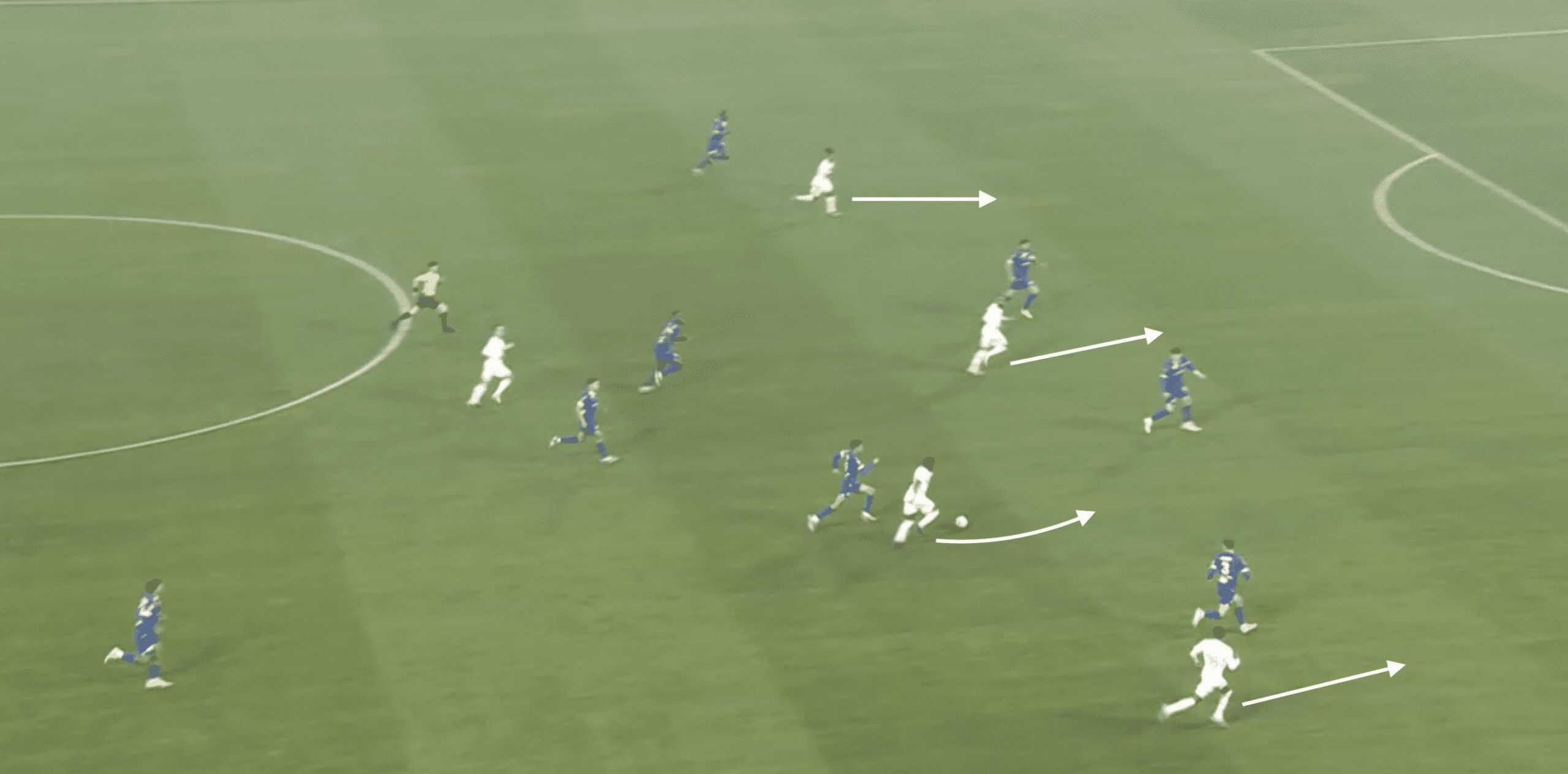
Their aggressive approach remains when they are out of possession, with the Lyon forwards looking to press as a unit in the initial phase of build-up play.
Although this represents a hugely positive development compared to their more passive showings at the beginning of the season, it still represents itself as an area of potential weakness once their initial press is bypassed and the opposition can exploit gaps in their defensive structure.
However, it must be stated that the notable difference at this stage of the season would be that Sage’s greater defensive stability gives Lyon increased freedom to press without ruing the consequences should they be caught out.
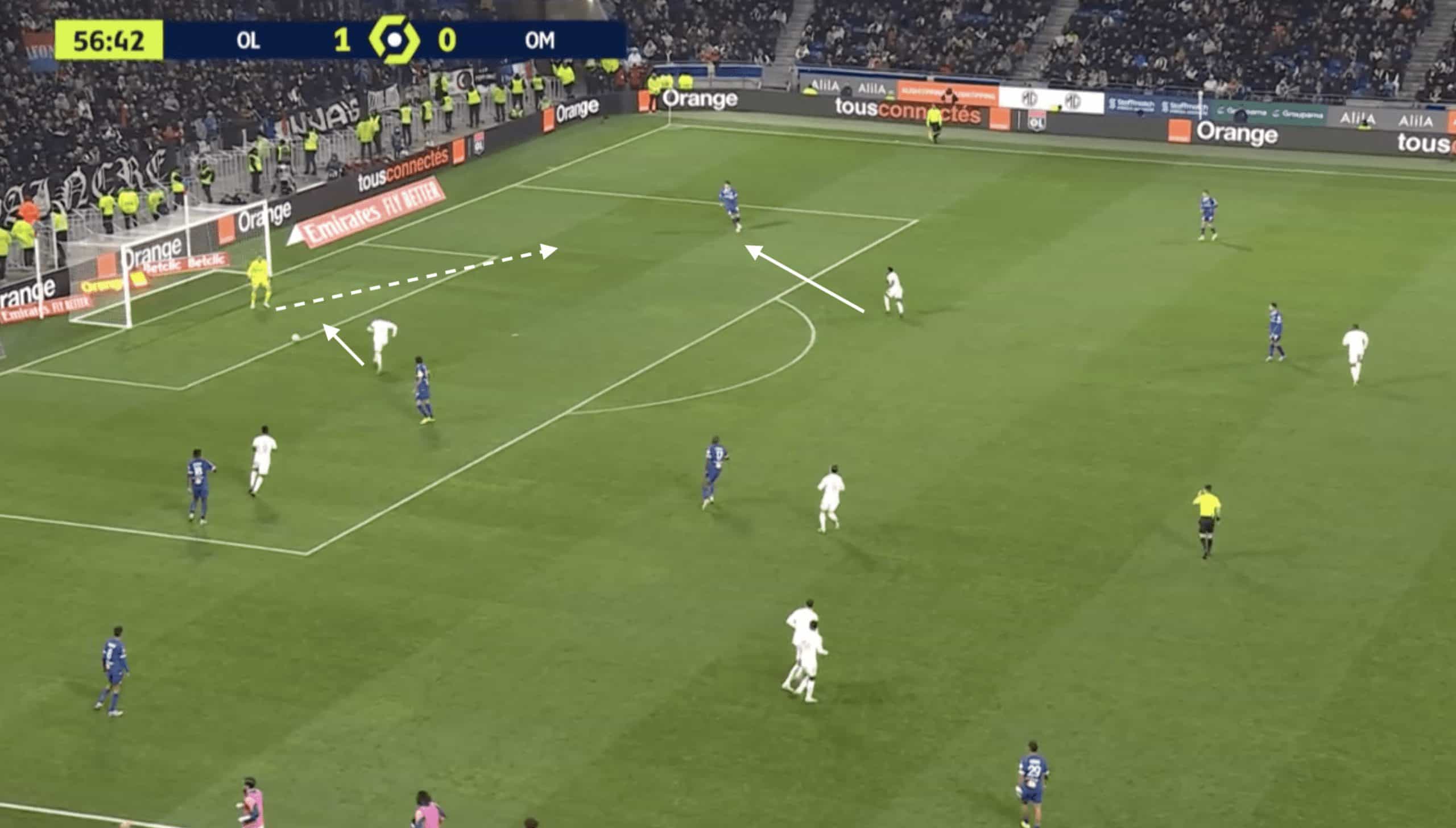
Olympique Lyon Increased defensive stability
Having joined Lyon in such a dire state, one of the most important issues for Pierre Sage to address would have been their leaky defensive line, which was so prone to conceding goals.
There are several ways in which Lyon has looked to set up without the ball, the majority of which being seamless transitions from their attacking structure.
When originally shaping up in the 4-3-3, Lyon can quite quickly drop into a 5-2-3, with Matić assuming a positional as the central defender out of the 5.
This not only increases the number of defensive support at their disposal but crucially allows Lyon to be compact and have the ability to widen their defensive line to protect against attacks down the flanks.
It also adds the crucial element of not being too negative either, with one of the central defenders having the chance to jump out towards the ball carrier and close down to protect against shots from the edge of the box.
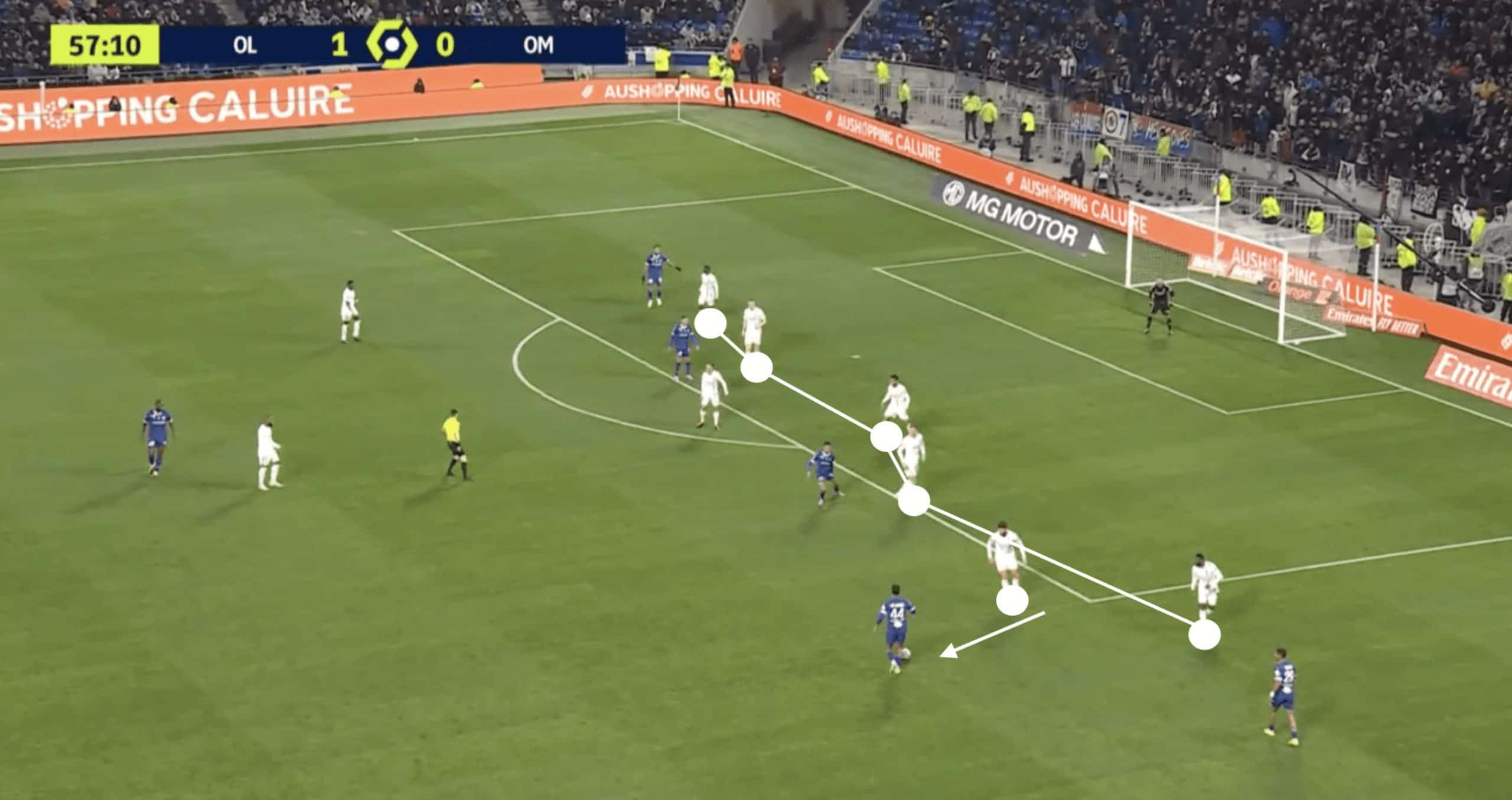
Their recent fixture against OGC Nice was an excellent example of how coaching changes have aimed to fix glaring issues against top opposition.
In the reverse fixture under Laurent Blanc’s management, Lyon was accused of being too passive and failing to stifle Nice attacks due to their narrow defensive structure and lack of defensive intensity.
However, on this occasion, Lyon were much more proactive when covering ground and looking to regain possession high up the pitch.
As shown in the image below, Lyon formed a 4-1-4-1, with Tolisso drifting across to cover in left back with Tagliafico advancing to press the ball carrier.
Due to his intent on stepping up, he forces the Nice player inside the pitch where Lyon has the numerical superiority, resulting in a turnover as Caqueret can intercept the errant pass.
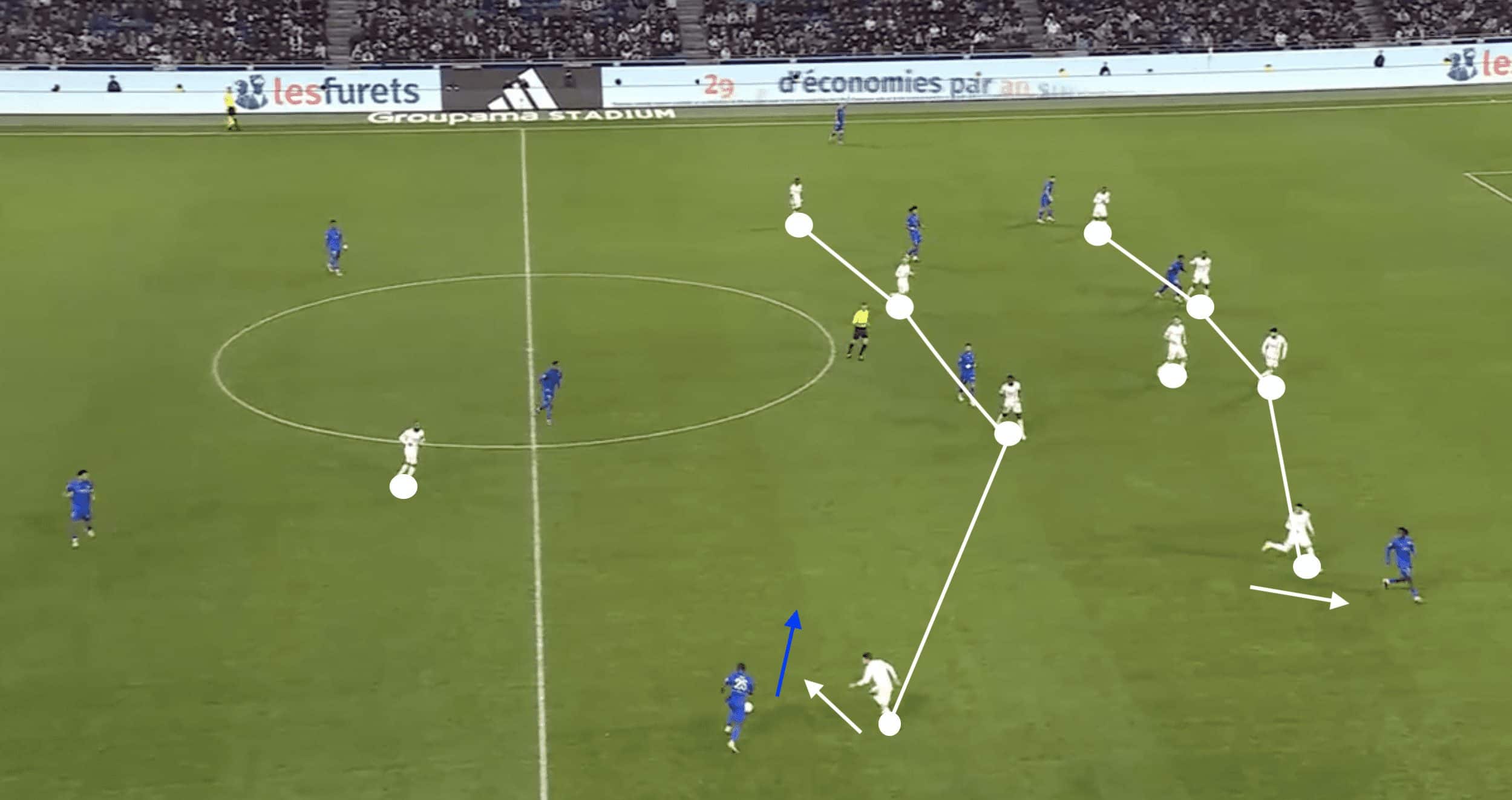
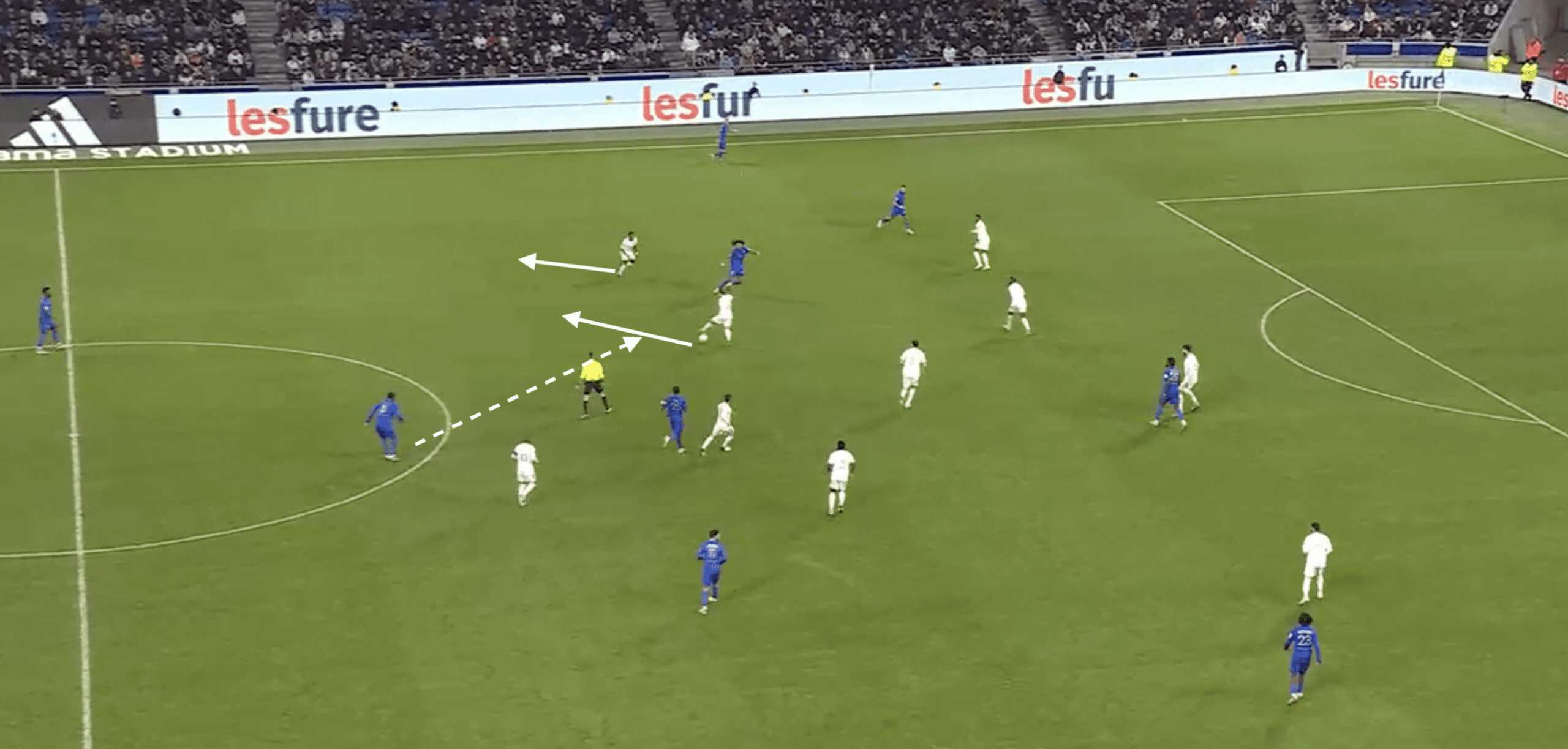
In the event that Lyon needs to find some more attacking inspiration, we have seen them morph into the 4-2-3-1.
This aims to sacrifice one of the advanced central midfielders for a more attacking playmaker, often causing Matić and Caqueret to form a double pivot to protect the defensive line.
Even though fans of Les Gones would prefer Caqueret not to revert to the defensive duties we saw earlier in the season, his partnership with the Serbian powerhouse allows him to advance with the peace of mind that his midfield counterpart will negate the opponent’s progression should the ball be lost.
The only glaring flaw with this setup would be that it often creates too much space out wide due to the lack of width from the attacking midfielders, with Sage’s men working hard to neutralise optimal passing lanes towards the flanks.
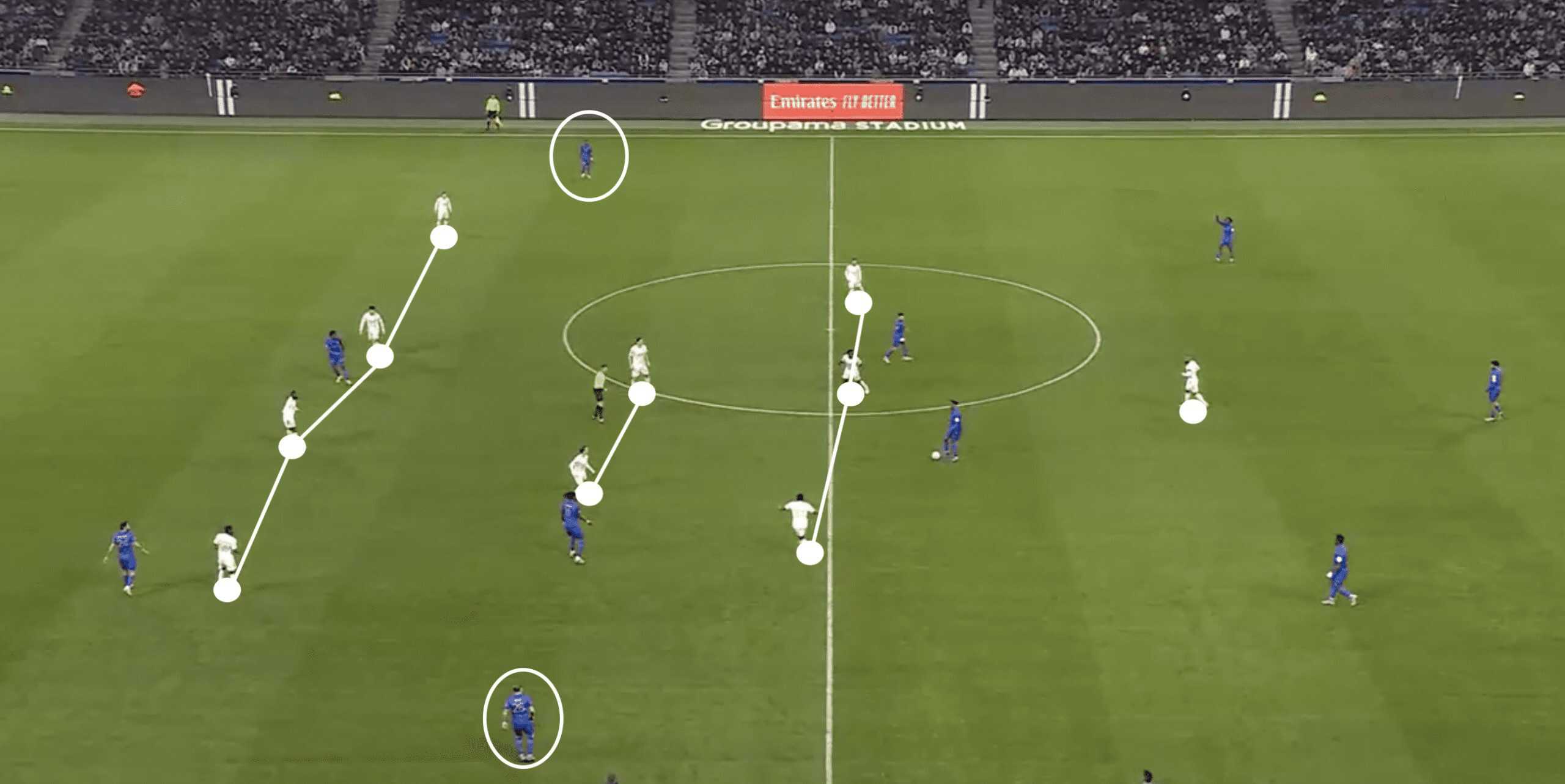
Conclusion
It would be fair to assume that the name Pierre Sage wouldn’t have filled Lyon fans with too much optimism when he was appointed as their club’s third manager this campaign.
However, the reality of the matter has become so much more fruitful than they could have ever imagined, with the young French manager giving them a new lease of life and propelling them from the bottom of the table.
Having charmed both the fans and the players, it will be intriguing to observe the decisions that Lyon makes regarding his long-term future at the club.
One thing is for certain: Sage has harnessed both existing experience and youthful qualities to restore harmony within the Auvergne-Rhône-Alpes club.





Comments